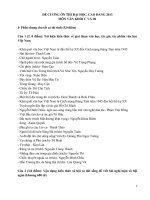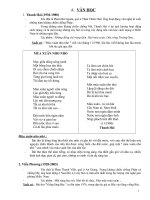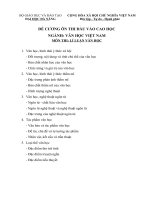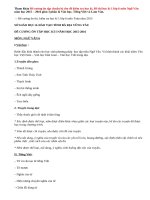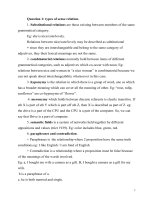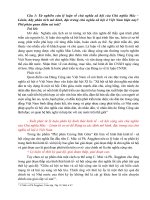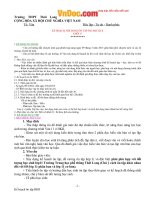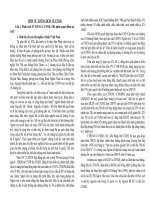Đề cương ôn thi môn Ngữ nghĩa học hay, chọn lọc
Bạn đang xem bản rút gọn của tài liệu. Xem và tải ngay bản đầy đủ của tài liệu tại đây (113.57 KB, 11 trang )
Question 1: types of sense relation.
1. Substitutional relations are those existing between members of the same
grammatical category.
Eg: she is nice/cute/lovely.
Relations between nice/cute/lovely may be described as subtitutional
+ since they are interchangeable and belong to the same category of
adjectives, they their lexical meanings are not the same.
2. combinatorial relations normally hold between items of different
grammartical categories, such as adjectives which co-occur with noun. Eg:
relations between nice and woman in “a nice woman” is combinatorial because we
can not speak about interchangeability whatsoever in this case.
3. hyponymy is the relation in which there is a group of word, one os which
has a broader meaning which can cover all the meaning of other. Eg: “rose, tulip,
sunflower” are co-hyponyms of “flower”.
4. meronymy which holds between discrete referents is clearly transitive. If
sth X is part of sth Y which is part off sth Z, then X is described as part of Z. eg:
the drive is a part of the CPU and the CPU is a part of the computer. So, we can
say that Drive is a part of computer.
5. semantic fields is a system of networks held together by different
oppositions and values (trier 1939). Eg: color includes blue, green, red.
6. paraphrases and contradiction.
+ Paraphrases is the relationship where 2 proposition have the same truth
conditions.eg: I like English / I am fond of English
+ Contradiction is a relationship where a proposition must be false because
of the meanings of the words involved.
Eg: a, I bought my wife a camera as a gift. B, I bought a camera as a gift for my
wife.
b is a paraphrase of a.
c, he is both married and single.
1
This sentence expresses a contradiction. It must be false because of the senses of
married and single are incompatible in that no one can be both married and single
in normal circumstances of communication.
7. lexical gaps is used to refer to the absence of a lexeme/word at a
particular place in the structure of a lexical field.
Eg:+ corpe: body of a dead human being.
+ Caroass: body of dead animal but no word for dead tree.
8. marked and unmarked term. Marked term is the presence or absence of
some particular elements of form. Eg: hats, boxes. Unmarked terms is the original
word. Eg: hat, box.
Question 2. implicature, types, eg
- The term implicature is used by Grice 1975 to account for what a speaker
can imply, suggest, or mean, as distinct from what the speaker literally says.
Types:
1. conventional implicature is an additional unstated meaning associated
with the use of a specific word. It includes: common conventional implicature. Eg:
“a but b” implies a contrast between a and b, so contrast is a conventional
implicature of “but”; scalar conventional implicature is an additional meaning of
the negative of any value higher on a scale than the one uttered. Eg: in saying
“Some children” the speaker implies that he says does not apply to “all children”.
Some is not all.
2. conversational implicature: generalized conversational implicature is an
additional unstated meaning that does not depend on special or local knowledge.
Eg: a: did you buy bread and milk. B: I bought some bread. I bought some bread
means I did not buy milk. Particularised conversational implicature is an
additional unstated meaning that depends on special or local knowledge. A: would
you like another beer? B: of course, yes.
Question 3. Synonyms, types, ex
2
- Synonyms are actually words of the same parts of speech which have
similar meaning, but not identical meanings.
- Synonyms may be classifies into 7 groups.
1. absolute synonyms. They are extremely rare in English and probably in
any other languages. Eg: semantics – semasiology.
2. semantic synonyms, they are those which differ in term of their
denotation. Eg: glance – look. 3. stylistic synonyms. They are those which differ
in terms of their connotation, eg : father – dad.
4. semantic stylistic synonyms make up the majority of all synonyms in
English – word differing both in denotation and connotation meaning. Eg: to
reduce – to cut back.
5. phraseological synonyms, ie, words different in their collocations. Eg: do
– make.
6. territorial synonyms, they are those employed in different regions like
Britain, Canada, Australia or the united states. Eg: autumn – fall.
7. euphemisms, which literally means speak well in using euphemisms, a
less unnpleasant or offensive effect is achieved. Eg: wc – bathroom, restroom.
Question 4. Homonyms, types, ex
- Homonyms are different words which have identical form or identical
sounds or both but different meaning. - According to sound form, it may be
classified into:
1.full/perfect homonyms: words identical both in pronunciation and spelling.
Homonyms are the same part of speech .eg: fast (go without food), fast (a kind of
food).
2.partial homonyms: words identical in pronunciation or spelling. They are
homonymous only in some of the forms of their respective paradigms. They may
be of the same or different parts of speech.
They are of 2 main subtypes:
3
2.1. homophones: words identical in pronunciation, but different or
coincidential in spelling. (buy-by).
2.2. homographs: words of the same spelling, but of different pronunciation
(tear – tear).
- According to types of meaning, it may be classified into:
1, lexical homonyms: word of the same part of speech, but of different
meanings and there is no semantic relation between them. Eg: board: black board,
board of directors.
2. grammatical homonyms: words of different parts of speech. Eg: work(n),
work(v)
Question 5. Presupposition, types, ex
- Presupposition is the assumption the speaker makes about what hearer is
likely to accept without challenge. Eg: have you stopped smoking? > you have
smoked before.
Types:
1. existential: mary’s brother is handsome > mary has at least 1 brother or
there exist somebody named mary.
2. lexical: tom came late again> tome came late before.
3. structural: where did you go lastnight? You go somewhere last night.
4. factive: I know tom came late > tom came late=factive,
5. non_factive:I dreamed of becoming a teacher > I am not a teacher.
6. counter-factive: if he were here by now > he is not only here but can be
never here now.
Question 6. Participants, types, eg
- The participants are those roles involved in the process (expressed by the
predicator)
Types:
1. agentive, including agent and actor – the creater of the process, he kicked
the dog.
4
2. instrumental – the instrument involved in the process, she takes a book
to hit her.
3. factive, the entity which is the result of the process, she wrote a letter.
4. locative – indicates the position or direction of the action or state
expressed by the verb, he works at home.
5. owner and possession, she has a beautiful girl.
6. benefactive – the entity that benefits from the action expressed by the
verb, also called beneficiary, my mother bought a car for me.
7. Comitative – the participant that accompanies the subject involved in a
process or action expressed by the verb, she went to the cinema with him. 8. source
– the point of origin of where the process comes from. He searched the information
from the internet.
9. goal – the target, to which an action is directed, his mother hit him.
10. undergoer – just the participant that undergoes or experiences a
process, I have lived here for 10 years.
11. the behaver, the participant that behaves, she laughed loudly.
12. the carrier and attribute, the participant or entity that has the feature
expressed by attribute, he is handsome.
13. the identifier and identified, identified is the participant or entity that is
identified by the identifier, the chair man is my brother.
14. the existent: the participant or entity that exists, water boils at 100c.
Question 7. Definition of process, types of process, eg
- Process is a powerful concept which represents the possible worlds as
consisting of going on, off doing, happening, feeling, being.
Types:
1. material processes are processes of doing. A material process usually
involves an actor and a goal, she made a car.
5
2. mental processes are processes of sensing. A mental process involves a
senser and a phenomenon, eg: I like this pen. It can be subdivided into perception
(seeing, hearing), affection (hearing, fearing), cognition (thinking, knowing).
3. relational processes are processes of being, a relational process has 2 part
to the being. It involved identifier and identified (that chairman is my brother),
carrier and attribute (she is nice), owner and possession (that book id lan’s).
4. behavial processes, involves a participant called behaver and process
(she smiled).
5. verbal processes are processes of saying, involved a sayer, verbiage, s
target snf receivr (I say it loud to everyone.
6. existential processes: lie between material and relational processes
represent sth that exist or happen (there is a red rose in the garden)
Question 8. Definition of circumstance, types, eg
- This component is related to process, typically occur freely in all types of
process. Most circumstances can be realized by prepositional phrases sometimes
can be a clause.
Types:
1. time: he goes to school at 7 am.
2. place: hoa is in the class.
3. condition: if I were you, I would buy a car.
4. concession: inspite of his parent objection, she still went abroad.
5. result: lanis studied hard so she is passed the exam.
6. cause: because of the rain, the flight was delayed.
7. manner: she beats her students with a ruler.
8. attending circumstance: as everyone is here, let’s start.
9. purpose: she is out for lunch now.
Question 9. Distinguish metaphor with simile
6
- A simile is an explicit or direct comparison in which something is
compared to sth else by the use of a function word such as like or as. It is an open
comparison.
- Metaphor is hidden comparison, is an implicit or indirect comparison in
which no function word is used. Sth is described by starting another thing with it
can be compared. He is a mouse (metaphor), she is like a mouse (simile)
Question 10. Conditions for a synonym to be absolute
- Lyons 1995 introduces the notion of absolute synonymy. According to
him, 2 or more expression are absolute synonyms if and only if they satisfy the
following 3 conditions:
1, all their meanings are identical,
2, they are synonymous in all context,
3, they are semantically equivalent on all dimensions of meanings and
descriptive and non-descriptive. Eg: semantics – semasilogy
Question 11. Conditions for a homonym to be absolute
- 2 or more expressions are absolute hymonym if and only if they satisfy the
following conditions:
1, they will be unrelated in meaning,
2, all their form will be identical,
3, the identical forms will be grammatical equivalent.
Bank: a financial place – bank of a river.
Question 12. The bases to distinguish the form and word/expression
- Let’s look at this example: there is no way of telling what it is. There are 9
forms but also 8 word/expressions. Words and word forms are distinguished from
each other in terms of the distinction between lexical and grammatical meanings.
+ Forms of 1 and the same word have the same lexical meaning whereas
different words have different lexical meanings. Eg: is – are
+ Two different words must have different lexical meaning.
Eg: be- go + There is no way of telling what it is
7
Question 13. The bases to distinguish metaphor and metonymy
-Metaphor is the transference of meaning from one object to another, based
on the similarity between 2 object. (she is a bee). =>based on the similarity of
characteristic between the woman (she) and bee( hardworking)
- Metonymy is the substitution of 1 word for another with which it is
associated , based on the relation of contiguity (I have 3 mouths to feed. 3
mouths=3 people)
Eg: we all live under the same roof. => roof is the house. Based on the
relation of contiguity so used a word ( a part or whole) to substitute (refer) to the
whole or a part of an object
Question 14. The bases to distinguish a homonymy and a hyponymy
- Homonymy refers to a situation where different words happen accidentally
to have the same forms. They are not connected semantically. They are quite
different words (he ran fast – quickly).
- Hyponymy is defined in terms of inclusion. This relationship is
hierarchical relationship. (the rose is the hyponym of flower which is the
superodinate.
- The hyponym is the member of the intensional meaning os which is
specific enough to cover the meaning of the superordinate whereas the
superordinate member is the one with the extensional mening broad enough to
cover the hyponym.
Hyponymy is a transitive relation. If x is a hyponym of y and y is hyponym
of x then x is the hyponym of z.
Question 15. Differences between sentence and utterance
- The difference between them are:
1. an utterance is an act of speech or writing at a particular time and in a
particular place. It happens just one. An utterance may consist of a word, a phrase,
a sentence or several sentences. But a sentence is not an event, it is a construction
of words according to certain rules which we often called grammatical rules.
8
2. the term sentence refers to the system or language side, it can be thought
of as the ideal structure hehind various realizations in utterances. Utterance on the
other hand refers to its realization.
3. sentence meaning as what a sentence regardless os the context or
situation in which it may be used. Utterance meaning on the other hand is what a
speaker means when he makes an utterance is a certain situation.
4. sentence meaning is highly context – independent, whereas utterance
meaning is not.
Question 16: 4 maxims related to the co-operative principle stated by
Grice
- The principle comprises 4 maxims: quantity, quality, relation, manner.
+ The 2 maxims of quantity are:
a, make yourself as informative as is required(for the current purposes of the
exchange)
b, do not make your contribution more informative than is required.
+ The quality maxims say: do not say what you believe to be false and do
not say that for which you lack adequate evidence.
+ The relation maxim says be relevant.
+ Grice’s specific maxims of manner are be perspicacious, avoid obscurity
of expression, avoid ambiguity, be brief, be orderly
Question 17. Example of conventional implicature:
Eg1: she is an air hostess, therefore she is beautiful
Eg2: A: it’s hot in here
B: really => implicature: A wants B to open the windows or the turn on the
fan
Eg3: A: would you like coffee or tea at home?
B: I have just drink tea at home=> implicature: B wants B bring him some
coffee
Question 18. Example of metaphor
9
Eg1: She is a bee => based on the similarity of characteristic between the
woman (she) and bee: hard working
Eg2: She shot a cold look at the man => cold= low temperature => uncaring
+ distance
Question 19. Example of metonymy
Eg1: The kettle boils => the water in the kettle boils
Eg2: we all live under the same roof => roof is the house. Based on the
relation of contiguity so used a word ( a part or whole) to substitute (refer) to the
whole or a part of an object
Question 20. Example of necessary of true sentences and contingently
true sentence
+ necessary of true sentences: eg1: dog are animal/ eg2: snow is white =>
they are true in all possible circumstance (or by virtue of linguistic above)
+ contingently true sentence: eg1: Lan has many valuable painting => true if
Lan has; falsw she does not. Eg2: Magina carta was signed in 1215. => they are
contingently true sentences because they might have been or might have been or
might be false in other circumstance
=> Our ability to recognize the falseness of the sentence depend on our
knowledge about the meanings of the sentence and the history of things in the
world
Question 21. Example of meaning sentences and ungrammatical
sentences
- Meaningless sentences: meaningfulness of a sentence is conditioned by
how well form a sentence is sematically.
Eg1: one colorless green ideas sleep furiously => nothing is colorless and
green simultaneously. Ideas can’t sleep and nothing can sleep furiously
Eg2: that is a generous miser => a miser can not be generous
- Ungrammatical sentence: grammatical sentences are not necessarily
meaningful or acceptable. Eg1: I want that he came => I want him to come
10
Eg2: I want a eat a cake big => I want to eat a big cake.
THE END
11
